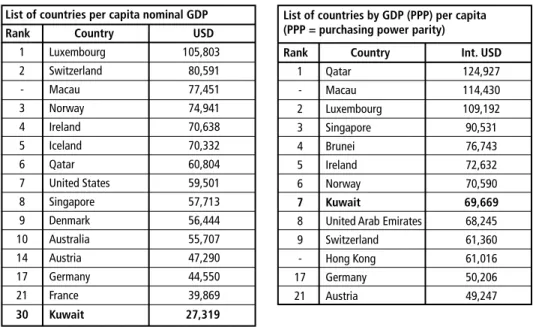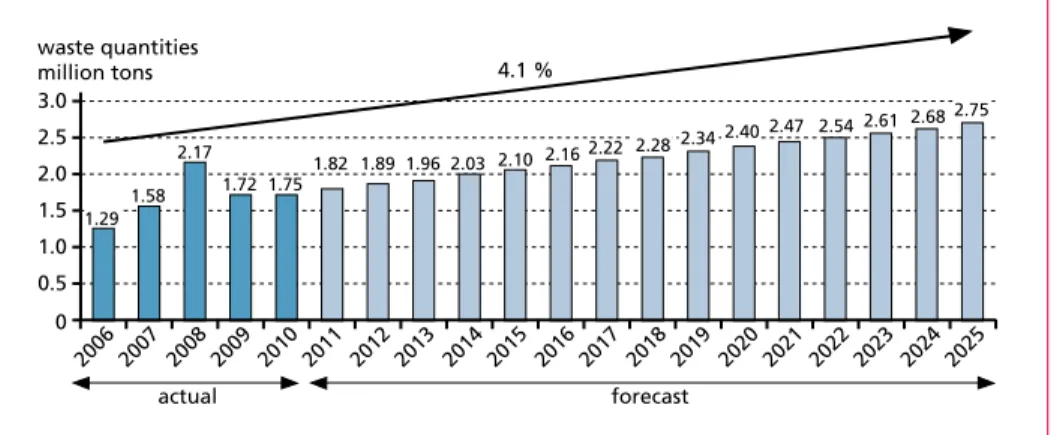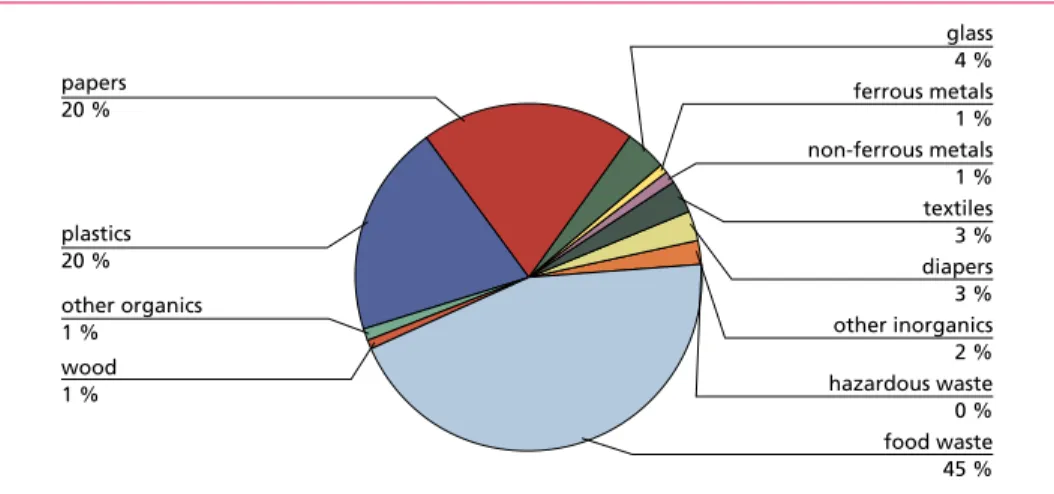Country Reports
Current Status, Waste Management Strategies and Planning in Kuwait
Manfred Graf
1. Basic information ...127
1.1. General overview about Kuwait ...127
1.2. Regulation/laws regarding waste management ...130
2. Actual situation in the field of waste management ...132
3. Initiatives ...134
3.1. General Initiatives/goals ...134
3.2. Recent initiatives in the field of solid waste management – the Kabd waste to energy project ...135
4. References ...136
1. Basic information 1.1. General overview about Kuwait
Geography Located in the north-east corner of the Arabian Peninsula with a size of about 18,000 km² Kuwait shares land borders with Iraq and Saudi Arabia, and maritime borders with Iraq, Saudi Arabia, and Iran.
Figure 1: Location plan of Kuwait and its
neighbour states Figure 2: Location plan – Kuwait
Country Reports
Climate
Summers in Kuwait are some of the hottest on earth like Mitribah in the Northwest of Kuwait with a recorded temperature of 54 °C on July 21, 2016. Kuwait experiences colder winters than other GCC countries because of its location in a northern position near Iraq and Iran.
Month Unit Jan Feb Mar Apr May Jun Jul Aug Sep Oct Nov Dec Year Average high °C 18 20 26 31 38 43 45 44 42 35 27 20 32 Daily mean °C 12.7 14.8 19.3 24.7 30.4 34.2 36 35.9 32.7 27.5 20.3 14.5 25.3 Average low °C 7 9 13 18 24 27 29 28 25 20 14 8 19 Average
precipitation mm 26 16 14 15 4 0 0 0 0 2 16 20 113 Average rainy days 5 4 5 3 1 0 0 0 0 1 3 5 27 Table 1: Climate data for Kuwait
More data about the climate are available on http://www.met.gov.kw/. with special information about the dust situation. Dramatically sandstorms occur mainly during June and July due to heavy winds from the Northwest.
Population
The population structure of Kuwait is characterized by the very high proportion of foreign workers (around 2/3 of all inhabitants) Kuwait is one of the countries with the highest degree of urbanization (2004: 96 %); life expectancy in 2016 was 78 years.
Official language is Arabic, commercial language is English.
Population of Kuwait according to nationality
census Kuwaiti non-Kuwaiti Total Change year Number % Number % Number %
1950 152,000 -
1975 305,000 31 685,000 69 990,000 551 1985 470,000 35 1,230,000 65 1,700,000 72 1995 650,000 41 920,000 59 1,570,000 -9 2005 860,000 39 1,330,000 61 2,190,000 40 2016 1,300,000 33 2,900,000 67 4,200,000 92
Table 2:
Population of Kuwait
The increase in population is from 1950 to 2016 about 4 million people. That is more than 2,500 percent in just 65 years.
Politics
Kuwait is a constitutional emirate with a semi-democratic political system. The Emir is the head of state. The hybrid political system is divided between an elected parliament and appointed government.
Country Reports
The Constitution of Kuwait was promulgated in 1962. Kuwait is among the Middle East‘s freest countries in civil liberties and political rights.
The Constitution of Kuwait was ratified in 1962 and has elements of a presidential and parliamentary system of government. The Constitution stipulates that Kuwait must have an elected legislature (the National Assembly parliament). The Emir is the head of state, whose powers are defined in the Constitution.
Government The prime minister chooses the cabinet (government). The appointment of a new government requires the approval of the National Assembly. The Prime Minister is a member of the ruling family and is appointed by the Emir.
The Emir‘s powers are defined by the 1961 Constitution. These powers include ap- pointing the prime minister, who in turn chooses the cabinet (government). Upon the death of the Emir, the crown prince succeeds. The crown prince must be approved by an absolute majority of the members of the National Assembly parliament.
On January 15, 2006 the cabinet nominated the previous Prime Minister, Sabah Al Sabah, to be elected Emir. He won the majority of the votes in the parliament and then became the 15th Emir of the state.
Economy Kuwait has a petroleum-based economy petroleum is the main export product. Kuwait is the second richest GCC (Gulf Cooperation Council) country per capita (after Qatar).
Petroleum accounts for half of GDP and 90 % of government income. Non-petroleum industries include financial services. In the past five years, there has been a significant rise in entrepreneurship and small business start-ups in Kuwait.
Despite its relatively small territory, Kuwait has proven crude oil reserves of 104 billion barrels, estimated to be 10 % of the world‘s reserves. According to the Constitution, all natural resources in the country are state property. During the 1991 Kuwaiti oil fires, more than 500 oil lakes were created covering a combined surface area of about 35.7 km². The oil spills during the Gulf War also drastically affected Kuwait‘s marine resources.
The Kuwait Investment Authority (KIA) is the world‘s oldest sovereign wealth fund.
Since 1953, the Kuwaiti government has directed investments into Europe, USA and Asia Pacific. As of 2015, the holdings were valued at 592 billion USD in assets. It is the 5th largest sovereign wealth fund in the world. Among KIA’s high-profile investments is Daimler AG and BP.
Kuwait is a major source of foreign economic assistance to other states through the Kuwait Fund for Arab Economic Development (https://www.kuwait-fund.org/en/web/
kfund). In 1974, the fund‘s lending mandate was expanded to include all developing countries in the world.
Country Reports
1.2. Regulation/laws regarding waste management
The key regulations/laws are
• decision No. 210/2001 Pertaining to the Executive By-Law of the Law of Environ- ment Public Authority, and
• law No. 42 of 2014 Promulgating The Environment Protection Law
In view of focusing attention on the environmental issues, the Government of Kuwait established the Kuwait Environment Public Authority (K-EPA) in 1996 to rehabilitate the national resources and organize the administrative environmental structure of Kuwait.
With the integrated efforts of various institutions that have come together for pre- servation of environment resulted in passing of a decree in 1980, which enforced the law for protection of the environment. Decision No. 210/2001 represents an executive by-law of the K-EPA pertaining to the Environmental Standards in the state of Kuwait.
Based on Decision No 210/2001 KEPA standards for waste to energy (WtE) plants are shown in the table below.
Appendix No. (11) with the subtitle Management of Domestic Wastes, Hazardous Was- tes, Health Care Wastes and Sludge Wastes includes for example The List of Hazardous Characteristics as per Basel Agreement (H1 – H13), categories of wastes to be controlled, transportation and disposal of hazardous waste and also the criteria of reated drainage waste water used in irrigation.
List of countries per capita nominal GDP
Rank Country USD
1 Luxembourg 105,803 2 Switzerland 80,591
- Macau 77,451
3 Norway 74,941
4 Ireland 70,638 5 Iceland 70,332
6 Qatar 60,804
7 United States 59,501 8 Singapore 57,713 9 Denmark 56,444 10 Australia 55,707 14 Austria 47,290 17 Germany 44,550 21 France 39,869
30 Kuwait 27,319
List of countries by GDP (PPP) per capita (PPP = purchasing power parity)
Rank Country Int. USD 1 Qatar 124,927 - Macau 114,430 2 Luxembourg 109,192 3 Singapore 90,531 4 Brunei 76,743 5 Ireland 72,632 6 Norway 70,590
7 Kuwait 69,669
8 United Arab Emirates 68,245 9 Switzerland 61,360 - Hong Kong 61,016 17 Germany 50,206 21 Austria 49,247
Source: International Monetary Fund 2017
Table 3: List of countries by per capita nominal GDP and by GDP per capita
Country Reports
The ambient air quality standards regulated in Appendix 17 are comparable to inter- national levels as shown in the table below
Table 4: Main standards for Waste-to-Energy plants in Kuwait Subject Appendix and clauses
of EPA By-Law Regulatory bodies
waste management Appendix 11
waste disposal Clause 19-29 Kuwait Municipality
sanitary water standards Appendix 14 Ministry of Public Works, PAAFR ambient air quality Appendix 17
air pollutant from fixed facility limits Appendix 20 noise level limits Appendix 18
occupational health exposure Appendix 6 Ministry of Health (MOH)
Table 5: Ambient air quality standards for residential areas
Pollutant Unit hour* 8 hours day** year
ppb mg/m3 ppb mg/m3 ppb mg/m3 ppb mg/m3 Sulfur Dioxide SO2 170 444 - - 60 157 30 80 Hydrogen Sulphide H2S 140 200 - - 30 40 6 8 Nitrogen Dioxide NO2 100 225 - - 50 112 30 67 Carbon Monoxide CO 30,000 34,000 10,000 11,500 8,000 9,000 - -
Ozone O3 80 157 60 120 - - - -
Ammonia NH3 800 850 - - - - 140 148
Hydrocarbon Combounds 1/10 from specified rate in works environment (TLV´s) without Methanes 0.24 ppm for three hours from 6:00 – 9:00 morning (a.m)
Suspended particulate matter PM-10 - - - - - 350 - 90 Dust – Fall out Matter - - - - - - 7.5
ton/km2
Lead - - - - - - 1.5
mg/m3
Chlorine*** 30.0
100 - - 10 30 - -
(30 min)
* Average hour should not occur more than twice during the period of 30 days on the same site
** Daily average (24 hours) should not occur more than once during the year
*** Should not occur more than once per year
- Should apply in residential dominated areas that lie on the border of industrial areas
Source: Kuwait EPA Act 210, Environmental Public Authority Decision No.210/2001 (2001)
It can be detained that a lot of limits/standards are regulated in the Decision No. 210/2001 even for incineration plants. Article 35 includes the Technical Specifica- tions and Allowed Averages of Emissions from Hazardous Incinerators but there are no specific requirements of Emissions Limit Value (ELV´s) for non-hazardous (municipal solid waste, MSW) incinerators defined on the existing Kuwaiti legislation.
Country Reports
The tender authority has had prepared a comparative study of the regulatory framework for WtE plants according to several relevant national and international standards (EU, Japan, US EPA). As the European Directive (IED) is the one with strictest requirements for waste incineration and the control of pollution it was considered as reference for regulating the ELV´s.
2. Actual situation in the field of waste management
According to the studies made for the waste to energy project Kabd tendered in 2015 currently in Kuwait very limited research has been carried out on the sector of waste management and data and information are non-existent in many cases:
The common method of solid waste disposal in Kuwait is still land filling. At the moment with an ongoing improvement to change from uncontrolled land filling sites to controlled dumpsites with the goal to treat non-hazardous waste in state of the art Waste to Energy plants in the future.
The following graphic shows that landfilling is the main method to dispose waste in Kuwait and this is very opposite to other developed markets. [2]
The following figures are mainly extracted from a presentation of the responsible au- thority in October 2014. The data mentioned there are based on a very detailed survey made by an international consultant by order of this authority. The main object of this study was to determine the current and the future waste composition and quantities for a waste to energy project tendered in 2015.
0 landfill
20 40 60 80 100
Britain Netherlands Demark Germany Kuwait
incineration recycle/composted/other
The report considered different socio-economic and building structures like industrial areas, residential areas. The investigations and samplings took place at different times of the year to get an overview even about possible yearly differences.
The amount of waste was estimated
a) by KM (Kuwait Municipality) on the count of the trucks delivering to the landfills and an average load per truck and
Figure 3:
Comparison of waste disposal methods: Kuwait versus other developed markets
Country Reports
b) waste quantities recorded on the Seven South Ring Road Landfill for 2012 and 2013 The figures were counterchecked with the waste generation rate in kg/capita/day as a reliable and worldwide accepted indicator.
Based on this the yearly amount of waste was defined with 2,018,302 tonnes per year of MSW (91 %) and agricultural waste in 2013 (9 %). This leads to a waste generation rate of 1.5 kg/capita per day. This figure is on the lower end of the range published by the World Bank (2012). For high income countries like Kuwait the range indicated is between 1.1 up to 4.5 kg/capita per day. At the moment the waste is transported and disposed of at three landfills.
3.0
waste quantities million tons
2.5 2.0 1.0 1.5 1.58
1.72 1.75 1.82 1.89 1.96 2.03 2.10 2.162.22
2.47 2.54 2.61 2.68 2.17
0.5 0
4.1 %
actual forecast
200 6
200 7
200 8
200 9
201 0
201 1
201 2
201 3
201 4
201 5
201 6
201 7
201 8
201 9
202 0
202 1
202 2
202 3
202 4
202 5 1.29
2.28 2.342.40
2.75
Figure 4: Waste quantities future development – municipal solid waste demand – 2006 to 2025
Source: Kabd Municipal Solid Waste Project_Official Presentation Oct. 2014
At the moment the waste is transported and disposed of at three landfills.
• Seven South Ring Road landfill
• Minaa Abedalla landfill
• Al Jahrah landfill
The above mentioned amount is also the basis to forecast the quantities until 2040. With an estimated population of approximately 7,5 million inhabitants and a corresponding total municipal solid waste quantity of around 4 million tons per year-
Having these figures in mind the projected Kabd – waste to energy plant will be res- ponsible for the state of the art thermal treatment of around one quarter of the total amount of municipal solid waste. The projected plant will therefore in no way contradict any future planned recycling measurements.
Waste quality Derived from the very comprehensive field investigations and surveys the waste com- position was determined as shown in Figure 5.
Country Reports
Figure 5: Waste composition in Kuwait
Source: Kabd Municipal Solid Waste Project_Official Presentation Oct. 2014
Low caloric value (LCV)
Calculated LCVs were determined applying the percentage shares of waste composition and moisture and ash content values from laboratory results (values from NAPESCO were applied in all LCV calculations), TA internal data and supported by scholarly literature
The mean LCV of 9,500 kJ/kg was finally determined for the proposed WtE facility Waste types to be delivered to the proposed waste facility
• waste originated from residential households,
• bulky waste,
• street sweeping waste,
• waste originated from local institutions,
• waste from commercial generators,
• non-hazardous health care waste,
• airport waste similar to waste from residential households,
• industrial waste similar to waste from residential households, and
• agricultural waste.
3. Initiatives
3.1. General initiatives/goals
The Government of Kuwait, in its Development Plan 2010 – 2014, has adopted a PPP pro- gramme to develop public infrastructure projects and to introduce private capital and ex- pertise in sectors otherwise under Government control. In support of the PPP programme,
hazardous waste 0 % wood
1 %
other organics 1 %
plastics 20 % papers 20 %
other inorganics 2 % diapers 3 % textiles 3 % non-ferrous metals 1 % ferrous metals 1 % glass 4 %
food waste 45 %
Country Reports
the State of Kuwait has enacted the PPP Law and the Executive Regulations which established KAPP. The responsible agency (KAPP – Kuwait Authority for Partnership Projects) has developed a roadmap that highlights top-priority projects and has iden- tified a total of eight sectors as key sectors. The sectors identified are: communication, education, healthcare, power, real estate, solid waste management, transportation, and water/wastewater.
3.2. Recent initiatives in the field of solid waste management – the Kabd waste to energy project
Technical data The Site is located in the Kabd area at a distance of approximately 35 km from Kuwait City with an area of 500,000 m2. The project‘s specific approach is based on using WtE technology to generate electricity, recover materials (metals) from bottom ash, and the disposal of the FGT residues and remaining bottom ash.
• MSW capacity of 3,274 tonnes per day (about 1,057,300 tonnes per year), average waste NCV of 9.5 MJ/kg,
• minimum of four lines (approximately 90 MWth per line),
• grate fired technology,
• energy recovery boiler,
• flue gas treatment system in compliance with Directive 2010/75/EU,
• steam turbine with ACC (air cooled condenser),
• metals (ferrous and non-ferrous) recovery from the bottom ash,
• a treatment and maturation plant on site, and
• two separate landfills to be established within the Site, for the controlled disposal of FGT residues and the remaining bottom ash.
Objectives of the Project
• diversion of MSW from landfilling for about half of the waste amount estimated for 2020 (more than two million tons per annum),
• generation of base load renewable energy,
• reduction in greenhouse gas emissions,
• support sustainable waste management, and
• protection of water ressources.
The successful bidder will be responsible for the design, build, finance, maintenance, operation (25 years) and transfer of the Facility.
Kuwait Municipality is responsible for the collection and transportation of MSW to the site.
Country Reports
4. References
[1] Kabd Municipal Solid Waste Project_Official Presentation Oct. 2014
[2] KPMG Advisory W.LL., Kuwait: Investing in Kuwait: A guide for Investment Opportunities in Ku- wait. Viewed on July 2018: https://e.kdipa.gov.kw/main/KDIPA-Investment-Guide-2016.pdf, 2016 [3] Kuwait EPA Act 210, Environmental Public Authority Decision No.210/2001 (2001)
[4] Law No. 42 of 2014 Promulgating The Environment Protection Law
Contact Person
Dipl.-Ing. Manfred Graf
EVN Umweltholding und Betriebs-GmbH Head Project Management
EVN Platz
2344 Maria Enzersdorf AUSTRIA
Phone: 00 43 - 22 36 - 2 00 - 13 403 Email: manfred.graf@evn-umwelt.com



